GALLUP NEWS SERVICE
PRINCETON, NJ -- The average American today is more worried about having enough money for retirement than about any of a series of other potential financial problems. Americans are slightly less concerned about paying the medical costs for a serious illness or accident, and less concerned still with paying normal medical costs and maintaining their accustomed standard of living. Americans are least concerned about making their minimum credit-card payments and paying for their mortgage, rent, or other housing costs. There have been few changes in these levels of financial concern since Gallup began asking these questions.
For the last four years, Gallup has given Americans a list of seven different financial concerns and has asked Americans to rate them in terms of "how concerned you are right now" about each financial matter. Here is the list of items, ranked by the percentage who are "very" or "moderately" worried about each, from Gallup's April 5-8 poll:
| Financial Concerns |
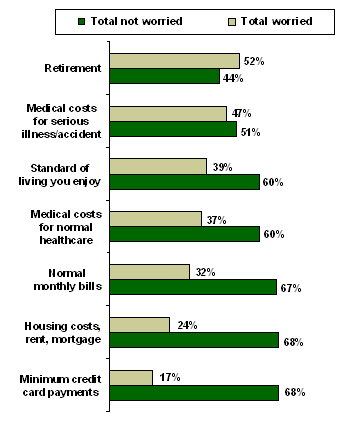 |
| April 5-8, 2004 |
The rank order is clear. Retirement concerns are at the top of the list, followed closely by worry about being able to pay for a serious illness or accident. There is less concern about maintaining one's standard of living, normal medical costs, and normal monthly bills, with the least worry expressed over being able to pay housing costs and meet minimum credit card payments.
The level of concern over these issues has not changed significantly during the last four years. In fact, worry about only two of the seven financial concerns is lower now than it was in 2001.
- Normal medical costs. The percentage of Americans saying they were at least moderately worried about having enough money to pay for normal medical costs was highest in 2001, at 44%. It decreased to 35% in 2002. In both 2003 and 2004, 37% of Americans were worried about paying for normal medical costs.
- Standard of living. In 2001, 43% of Americans were very or moderately worried about maintaining their standard of living. This dropped to 35% in 2002, but increased to 38% in 2003 and 39% in 2004.
|
Financial Concerns
|
||||
|
Percentage "very" or "moderately" worried |
2001 |
2002 |
2003 |
2004 |
|
% |
% |
% |
% |
|
|
Not having enough money for retirement |
53 |
54 |
54 |
52 |
|
Not able to pay medical costs of serious illness/accident |
50 |
45 |
46 |
47 |
|
Not being able to maintain standard of living |
43 |
35 |
38 |
39 |
|
Not being able to pay normal medical costs |
44 |
35 |
37 |
37 |
|
Not having enough to pay normal monthly bills |
32 |
30 |
30 |
32 |
|
Not being able to pay rent or mortgage |
24 |
22 |
25 |
24 |
|
Not being able to make minimum payment on credit cards |
18 |
15 |
16 |
17 |
Retirement
Having enough money for retirement is the only issue out of the seven tested about which more Americans express at least moderate worry than express little to no worry, with 52% worried and 44% not worried.
Concern about retirement shows significant differences by age:
| Concern About Having Enough Money for
Retirement by Age Group Percentage very or moderately worried |
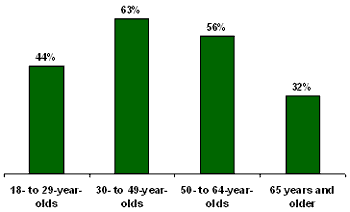 |
| April 5-8, 2004 |
In Americans' younger years, 18 to 29, having enough money for retirement must seem like a more distant concern, with just 44% in that age group saying they are very or moderately worried. But by the time Americans hit the 30- to 49-year age bracket, concern increases dramatically, with 63% expressing worry. Concern falls off slightly in the 50- to 64-year age group, but is still high, at 56%. Then, at age 65 and afterward, there is relatively little concern, presumably because most have already retired and are finding that they are getting by.
In fact, 82% of those who are retired (as reported in the early April Gallup Poll) say they have enough money to live comfortably -- compared with 72% of non-retired adults, the overall average of 74% of the total national adult sample, and only 61% of those in the youngest age group, 18-29.
Credit Card Payments
Of the seven financial issues tested, not having enough money to pay off credit cards is the least likely to cause anxiety for Americans. Only 17% are very or moderately worried about credit card debt, while 68% are not.
Of course, not everyone owns a credit card. In fact, the data from the poll show that 21% of adult Americans say they do not own at least one credit card. So is it possible that the low level of concern in the overall sample of Americans results from the lack of concern among those who don't have a credit card?
Here's what concern about credit card payments looks like among those with credit cards and among the entire national sample:
|
Concern About Making Monthly Credit Card Payments
|
||
|
Total |
Those with |
|
|
% |
% |
|
|
Very worried |
7 |
7 |
|
Moderately worried |
10 |
10 |
|
Not too worried |
22 |
25 |
|
Not at all worried |
46 |
51 |
|
No opinion |
15 |
6 |
The data show no more concern among those with credit cards than among the total sample. The simple fact is that the vast majority -- 76% -- of Americans with at least one credit card are not worried about having enough money to make the minimum payment on their credit cards each month.
So, how are credit card owners handling their credit debt? The poll included a question that asked respondents if they pay their balances in full every month, if they usually leave balances, if they pay only the minimum payment, or if they sometimes pay less than the minimum. For the entire population of credit card owners, the following table displays the relationship of their concern about credit cards to their usual monthly credit-card payment behavior:
|
Concern About Paying Off Credit Cards by
Amount of Monthly Balance Paid
|
|||||
|
Always pay off the balance |
Usually pay the full amount |
|
Usually pay only the minimum |
Usually pay less than the minimum |
|
|
% |
% |
% |
% |
% |
|
|
Very worried |
1 |
* |
2 |
2 |
2 |
|
Moderately worried |
1 |
2 |
5 |
3 |
* |
|
Not too worried |
7 |
4 |
10 |
5 |
* |
|
Not worried at all |
23 |
9 |
15 |
3 |
- |
|
* Less than 0.5% |
|||||
So, another way of looking at these data is as follows:
- Only 7% of the American credit-card-carrying population is in real trouble with credit card debt today: this group pays only the minimum or less than the minimum due each month and is also worried about paying the minimum.
- Another group of about 11% of credit card holders manage to pay more than the minimum most months, but are still worried.
- A small 8% of happy-go-lucky credit card owners pay only the minimum or less each month, but don't worry much or at all about it.
- The largest group of all, 68% of credit card holders, pays more than the minimum each month and doesn't worry about being able to make the payments.
"Standard" Worries: Paying Monthly Housing Costs, Normal Monthly Bills
Only between a fourth and a third of Americans say they worry about two quite "normal" financial situations: not having enough money to pay normal monthly bills and not having enough money to pay rent, mortgage, or other housing costs.
The following table displays the percentage of Americans who are in each category created by the combination of worry about these two financial concerns:
|
Concern About Paying Monthly Housing Costs by
Concern About Paying Monthly Bills
|
|||||
|
Normal Monthly Bills |
|||||
|
Very worried |
Moder- |
Not too worried |
Not at all worried |
No |
|
|
% |
% |
% |
% |
% |
|
|
Monthly Housing Costs |
|||||
|
Very worried |
9 |
2 |
* |
* |
* |
|
Moderately worried |
1 |
9 |
2 |
* |
* |
|
Not too worried |
1 |
4 |
18 |
3 |
0 |
|
Not worried at all |
1 |
3 |
6 |
33 |
0 |
|
No opinion |
* |
2 |
2 |
2 |
1 |
|
* Less than 0.5% |
|||||
These data show that:
- Twenty-one percent of Americans are in real financial anguish. They say they are worried both about having enough money to pay normal bills and about having enough money to pay housing costs.
- Eleven percent are in some financial anguish. They say they are worried about one or the other of these two situations, but not both.
- Six in 10 Americans are in better shape, meaning they say they don't worry much or at all about either of these financial matters.
It is clear that these concerns are directly related to one's current income, with lower- income Americans more likely than higher-income respondents to say they worry about these two problems.
|
Concern About Housing Costs and Normal Monthly Bills by Annual Income
|
|||||
|
Percentage "very" or "moderately" worried |
|
|
$30,000-$49,999 |
|
|
|
% |
% |
% |
% |
% |
|
|
Housing costs |
10 |
16 |
32 |
38 |
38 |
|
Normal monthly bills |
13 |
20 |
39 |
49 |
51 |
Worry About Maintaining One's Standard of Living
About 4 in 10 Americans say that they worry about being able to maintain their accustomed standard of living.
Worry about maintaining one's standard of living, of course, does not necessarily have to be related to one's income. A family with a million-dollar income could be just as worried about maintaining its standard of living as a family with a $15,000-a-year income.
The data, however, show that lower-income people are in fact much more likely than those at higher income levels to be concerned about maintaining their standard of living.
| Concern About Maintaining Standard of
Living by Annual Household Income |
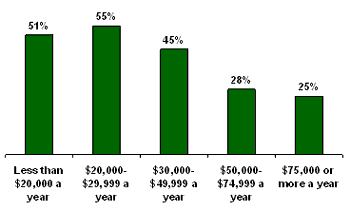 |
| April 5-8, 2004 |
The results also show that the elderly, those aged 65 and older, are less concerned about maintaining their standard of living than young adults are, with 30% of those aged 65 and older offering this response compared with 43% of those aged 50-64, 40% of 30- to 49-year-olds, and 44% of 18- to 29-year-olds.
| Concern About Maintaining Standard of
Living by Age Group |
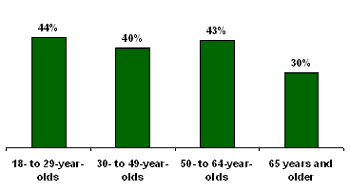 |
| April 5-8, 2004 |
Medical Cost Concerns
Paying medical costs for serious illnesses or accidents and paying medical costs for normal healthcare also worry Americans, ranking second and fourth, respectively, behind retirement on Gallup's annual list. Nearly half of all Americans, 47%, are worried about paying for the medical costs from a serious illness or accident. Thirty-seven percent are worried about paying for normal healthcare costs.
One might imagine that concern about paying for medical costs would increase with age, given the increasing prevalence of medical issues as one ages. Concern, however, is essentially constant across age groups, with those in the age range between 30 and 64 slightly more likely to be concerned than those in the youngest and oldest age groups.
| Concern About Ability to Pay Medical
Costs by Age Group |
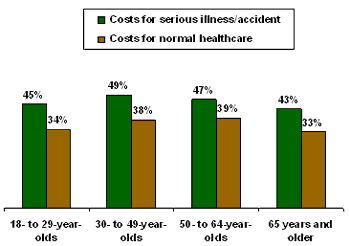 |
| April 5-8, 2004 |
Survey Methods
These results are based on telephone interviews with a randomly selected national sample of 1,014 adults, aged 18 and older, conducted April 5-8, 2004. For results based on this sample, one can say with 95% confidence that the maximum error attributable to sampling and other random effects is ±3 percentage points. In addition to sampling error, question wording and practical difficulties in conducting surveys can introduce error or bias into the findings of public opinion polls.
